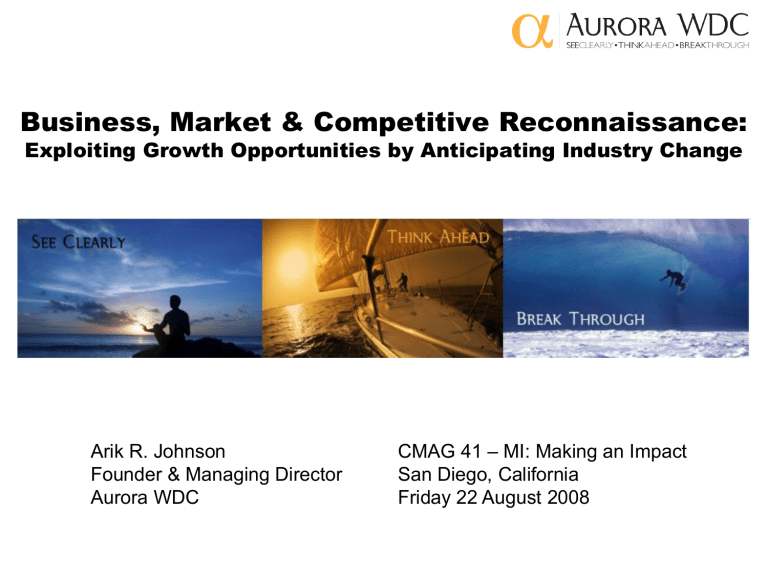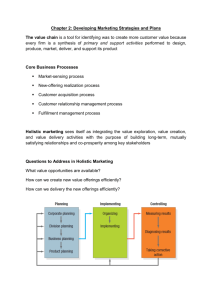Risk & Reward: Best Practices in Competitive Intelligence

Business, Market & Competitive Reconnaissance:
Exploiting Growth Opportunities by Anticipating Industry Change
Arik R. Johnson
Founder & Managing Director
Aurora WDC
CMAG 41 – MI: Making an Impact
San Diego, California
Friday 22 August 2008
Why do cars have brakes?
Why do cars have brakes?
How you answer that question reveals a great deal about how you approach both
Risk and Reward.
Most people would say brakes help slow you down… we think brakes help you go faster.
Competitive Intelligence
The controls that accompany risk management are a lot like the brakes on a car, and managing risk (of stagnation or market share loss) is the foundation of being able to exploit opportunities for reward (growth). CI inhabits the interface between the two with equilibrium its goal.
CI is the sensory apparatus that unites many otherwise disconnected mechanisms to enhance risk/reward visibility, understanding and predictability:
• headlights (tactical)
• in-dash performance indicators (operational)
• GPS (strategic)
Competitors, Customers & Technologies Are Complex Interdependencies
CI is about “Seeing Clearly” through Market Illusions
Defining Objectives for Today
• Learn how Competitive Intelligence has evolved to become a more opportunistic decision support tool in an era ruled as much by Innovation as
Competition
• Compare the use of Predictive vs. Emergent strategy analysis and how they are used to plan, execute and measure performance for future decision making
• Understand the latest techniques available today to understand and anticipate competitive activity based on Core Theories of Innovation (aka: Angles of
Attack)
• Discuss how to deliver Findings and Recommendations to decision makers that use the Collective Observations of the firm to ensure better performance results
Three Intelligence Trends
• Organizational Collaboration – Everyone in the
Firm is a Virtual Member of the CI Team
• Corporate Governance – Board-level Priority for
Ensuring Reliability of the Earnings Forecast
(Vioxx/Celebrex Impact, SarbOx 402, etc.)
•
Sustainable Innovation – Predicting Outcome of
Competitive Battles based on Product Strategy
& Predictable Dynamics
CI is About Decisively Minimizing
Threats & Maximizing Opportunities
• Minimizing Competitive Threats, e.g.
– Understanding Threats to Current Business Status Quo:
Competitors, Legislation, Technology Shifts,
Obsolescence, Substitutes, Customers Backwards
Integrating, Vendors Forwards Integrating, etc.
• Maximizing Market Opportunities, e.g.
– Identifying New Sales, Revenue and Profit Centers
– Develop New, Innovative Products & Services
– Benchmarking Cost Reduction and Efficiencies from
Direct Rivals & Best-of-Breed non-competitors
Traditional CI Follows a
Disciplined Process for
Information Collection and
Analysis
Needs
Planning &
Direction
Deliver, Inform
& Recommend
Tactical Users &
Strategic
Decision Makers
Analysis &
Production
The
Traditional CI
Cycle
Secondary
Research
Primary
Research
CI is About Better Decision-Making
• Strategic Decisions
– What Business are We in and Where are New
Opportunities for Growth?
• Operational Decisions
– How do we structure those business units to most effectively compete for and win Market Share?
• Tactical Decisions
– Which customers are available to us and how can we convince them to select us over any and all functional equivalents?
Porter’s Five Forces Model
SWOT Analysis
Core Competence
Two Fundamental
Competitive Analysis
Examples
The Product Life Cycle
Strategic & Tactical Realms of Competitive Advantage
“Competitive Strategy”
Marketing Warfare
Defensive
Market Leaders
• Attacking themselves with new ideas
• Blocking competitive moves
Offensive
No 2 or No 3
• Avoiding leader’s strengths
• Attacking leader’s weaknesses
Flanking
New Players
• Moving into uncontested area
• Element of surprise
Guerrilla
Small Players
• Finding market small enough to defend
• Prepared to bug out at moment’s notice
•
Principles of Defensive Warfare
–
Only the market leader should consider playing defense.
– The best defensive strategy is the courage to attack yourself.
– Strong competitive moves should always be blocked.
•
Principles of Offensive Warfare
– The main consideration is the strength of the leader's position.
– Find a weakness in the leader's strength and attack at that point.
–
Launch the attack on as narrow a front as possible.
•
Principles of Flanking Warfare
– A good flanking move must be made into an uncontested area.
–
Tactical surprise ought to be an important element of the plan.
–
The pursuit is just as critical as the attack itself.
•
Principles of Guerrilla Warfare
–
Find a segment of the market small enough to defend.
– No matter how successful you become, never act like the leader.
– Be prepared to bug out at a moment's notice.
-- Jack Trout
CI is a Critical Element in Strategy
COMMERCIAL MARKET
Market Attractiveness Competitive Position
Scope & Context
Strategic Issues
Insight
Financial Position
Economic Profitability Growth
CAPITAL MARKET
Scenarios & Options
Creativity
Chosen
Strategy
STRUCTURE & RESOURCES
Organizational Design
Projects & Resources
Stakeholder
Score Card
Critical Success Factors & Key Performance Indicators
Performance Monitoring & Incentive Compensation
MANAGED PERFORMANCE
Strategy Formulation Strategy Execution
Growth Vector Analysis
•
Growth Vector Analysis (GVA) reviews the different product alternatives available to the firm in relation to its market options, not already being pursued by competitors. Four complimentary characteristics are used for defining common threads of strategy:
– Product-Market Scope specifies particular industries to which a firm confines its position.
– Growth Vector indicates the direction a firm is moving relative to current product-market posture (market penetration, market development, product development and diversification).
–
Competitive Advantage defined as particular properties of individual product markets conveying a strong market position.
– Synergy is the combined effect on the firm’s resources that is greater than the sum of its parts.
Present Products
Improved Products New Products
Existing
Market
Expanded
Market
New Market
Market Penetration
Market Extension
Market
Development
Product Extension
Market Segmentation /
Product Differentiation
Product/Service Extension
& Market Development
Product Development
Product Development /
Market Extension
Diversification
Marshall McLuhan
“I don’t know who discovered water, but it wasn’t a fish.”
Strategy is concerned with what the corporation wants to do in the world.
Intelligence is focused on what the world wants to do to the corporation, whether they know it or not.
U.S. IC Apparatus Failed to Evolve
• New Threats (al Qaeda) Emerged on the
Geopolitical Stage in the Vacuum of
America's Return to International
Hegemony After the End of the Cold War
Connecting Emergent Phenomena
Parallel Reforms Create Equilibrium
• In Business, Corporations which place too much Emphasis on
Defensive Competitive Risk
Management find themselves Ill-
Equipped for Markets Driven by
Offensive Opportunities for
Innovation-based Growth.
• The Result is a Shift in Emphasis from a Focus on Polar Extremes to
Equilibrium & Mode-Switching between Incisive and Decisive Ends of a new kind of model:
• the Reconnaissance Continuum.
“Competing head-to-head can be cutthroat especially when markets are flat or growing slowly.
Managers caught in this kind of competition almost universally say they dislike it and wish they could find a better alternative. They often know instinctively that innovation is the only way they can break free from the pack.
But they simply don’t know where to begin. Admonitions to develop more creative strategies or to think outside of the box are rarely accompanied by practical advice.”
Chan Kim and Renee Mauborgne
Success Breeds Complacency
“It is a classic conundrum for business titans: How much money and attention should be focused on a new, but growing, operation that is far less profitable than the core business?”
- Prof. Clayton Christensen, The Innovator's Dilemma
The Duality Continuum of Reconnaissance includes Both Decisive & Incisive Sensing
Decisive
Frame of Reference is the
Decision, Less Trend-Dependent
Framework for Current Analysis
Compares Options & Outcomes
Recommendations and Trust
Top-Down Imposition
Driven by Issues
Decision & Action vs. ‘Nariyuki’
Factual & Hypothetical
Incisive
Scanning for Trends, there is no
“Decision” to be made
Framework for Interpretation
Recognize “Pattern Vector” History
Implications for the Reader
Bottom-Up Exposition
Driven by Trends
Outcome is Often Observation Itself
Emergent & Theoretical
Most Attempts at Innovation Fail
But by integrating three types of insights - customer needs, competitive patterns, and a company's own capabilities - and combining them with solid protocols, innovation becomes a routine competence and companies can double or triple their success rates. And the really big hits are often the products that innovate in not one but two or three or more
"innovation spaces."
The Ten Types of Innovation
Innovation
Category
Finance
Innovation
Type
Business model
Description of type
How you make money
Networks and Alliances
Process
Offerings
Delivery
Enabling process
Core processes
Product performance
Product system
Service
Channel
Brand
Customer experience
How you join forces with other companies for mutual benefit
How you support the company's core processes and workers
How you create and add value to your offerings
How you design your core offerings
How you link and/or provide a platform for multiple products.
How you provide value to customers and consumers beyond and around your products
How you get your offerings to market
How you communicate your offerings
How your customers feel when they interact with your company and its offerings
10 Examples
Process of Predicting Industry Change
Signals of
Change
Likely Outcome of
Competitive
Battles
Strategic Choices
Influencing
Success
Disruptive Technology
Customers “Hire” Products to Do
“Jobs” for Them
Concentrate Less on
What Customers “Want” and
More on What Customers “Need”
RPV Theory: Building Capabilities
Resources
Assets the Firm can Buy or Sell,
Build or Destroy
People
Technology
Products
Equipment
Cash/Brand/Distr.
Processes
Ways to Turn
Resources into
Products/Services
Hiring/Training
Product Dev.
Manufacturing
Budgeting
Research
Values
Prioritization
Criteria for
Decision-Making
Cost Structure
Income Statement
Customer Demand
Opp. Size
Ethics
Value Chain Evolution Theory
• Disruptive Business Models: Vertically Integrating VC to
Improve What’s “Not Good Enough” in the company’s products and services judged by customers.
• Performance Defining Subsystems: Companies must control all those activities and combinations of activities in the value chain that drive the product performance characteristics that matter most to customers.
• Specialists will seek to control performance drivers based on asymmetric differences in Motivation and Skills around a modular interface in the VC. (Sword & Shield)
Disruptive Innovation Theory
Performance
Sustaining Innovations
Better Products Brought to
Established Markets
Difference
Performance
Measure
Low-End Disruptions
Target Overshot Customers with a
Lower Cost Business Model
New-Market Disruption
Compete Against Nonconsumption
Nonconsumers or Nonconsuming Contexts
Time
Customer Demand & Signals of Change
1.
Non-Market Contexts: External Forces (Government, Economics, etc.) Increasing or Decreasing Barriers to Innovation
2.
Undershot Consumers: Opportunities for Up-Market Sustaining
Innovations
3.
Overshot Consumers: Opportunities for Low-End Disruption,
Shifting Profits by Specialist Displacements (Modularity) and the
Emergence of Rules
4.
Non-Consumers: Opportunities for New Market Disruptive Growth
Established Companies almost always
Lose to Disruptive Innovators
Process of Predicting Industry Change
Signals of
Change
Likely Outcome of
Competitive
Battles
Strategic Choices
Influencing
Success
The Reconnaissance Think Tank Model
TASKING > SENSING > INTERPRETATION
Questions or Comments?
www.AuroraWDC.com
Arik R. Johnson
Consulting & Training Institute
Arik.Johnson@AuroraWDC.com
+01-715-720-1616
Derek L. Johnson
Research & Analysis Bureau
Derek.Johnson@AuroraWDC.com
+01-608-268-3470









